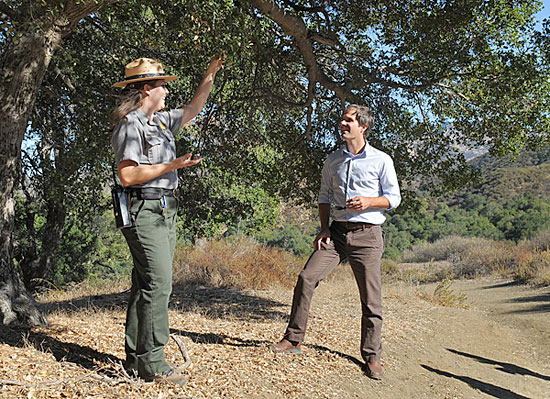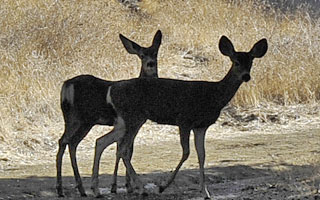The mountains’ new king of the hill
October 30, 2012
In 1976, David Szymanski’s grandparents took him on a Bicentennial road trip across the United States.
“I was eight,” he remembers. “We stopped at the Badlands and Mt. Rushmore, Yellowstone, Hoover Dam, maybe the Grand Canyon. The landscapes of the Great Plains and the West were so different in so many ways from what I was used to. I remember coyotes yipping in Montana and Wyoming. It was spectacular. I was amazed that such places existed.”
That amazement stayed with him—as a teenager in the Rust Belt, as a University of Michigan engineering student and, in his senior year of college, in a random-but-career-altering class on the literature of the American wilderness that “dredged up everything I’d felt at eight.”
Now Szymanski, a 44-year-old veteran of the National Park Service, is managing of one of Southern California’s own spectacular places as the new superintendent of the Santa Monica Mountains National Recreation Area.
Szymanski was named after a 10-month search for a successor to the popular Woody Smeck, who was the public face of the nation’s largest urban national park for more than a decade before moving on to a job as a deputy superintendent at Yosemite National Park.
It’s a tough act to follow, acknowledges Szymanski, who was half-joking but completely awestruck when he referred to Smeck as “St. Woody” during a recent meet-and-greet with public officials. The 153,750-acre recreation area is a complex jurisdictional patchwork with players at every level of government as well as powerful community and nonprofit interests; as superintendent, Smeck worked on everything from preservation guidelines for sensitive wildlife habitat to firefighting policy to funding for thousands of acres of open space acquisitions.
“He’s a great, great, great, great person,” Symanski says.
Szymanski, however, brings his own set of credentials, including long experience in areas with complex issues requiring cooperative management. He has spent nearly two decades working with parks and protected areas, including 14 years in the National Park Service.
His most recent stint was as superintendent of the Lewis and Clark National Historic Park in the Pacific Northwest, but he also has served at Everglades National Park in Florida, Voyageurs National Park in Minnesota, on the Senate Subcommittee on National Parks as a congressional fellow and, in the 1990s, in Madagascar, working in that country’s then-new national park system.
“I’ve always enjoyed working in places where we’ve had to work with communities and partners to get things done,” he says. “At Lewis and Clark, we included several state parks in our boundaries, and in the Everglades, it was often sugar farmers against fishing guys, and finding solutions among people that often otherwise wouldn’t be in the same room. This is the best place in the country for those kinds of things.”
On the job for all of three weeks, Szymanski has already hit the ground hiking, reaching out to stakeholders and learning the landscape even as he settles in with his wife, Elaine, and their 6- and 8-year-old sons, and tries to squeeze in the occasional bike ride (he’s an avid cyclist.)
“I’ve hiked from Newbury Park up the Boney Mountain Trail. I’ve biked the Backbone Trail. I went to Solstice Canyon with the granddaughter of [grocery store magnate] Fred Roberts, who assembled so much of the canyon property and sold it into conservation. I met the neighbors at Zuma and Trancas Canyons, and went to a lot of smaller areas. Of course, I’ve spent time at the new Visitor Center at the King Gillette Ranch.”
On a recent afternoon, he strolled along the Inspiration Loop Trail near the Visitors’ Center, discussing ways to improve signage—a small-but-complex question, particularly for pet owners, since the 5-minute walk between the center and the unmarked trailhead traverses both National Park land (which allows dogs) and land overseen by the Mountains Restoration and Conservation Authority (where dogs are forbidden).
But the hike, led by NPS Park Guide Bethany McCormick, was also a lesson in the storied history of the property’s Hollywood origins and its stints as a retreat for various cults and religions. And midway through, it was interrupted by a family of five mule deer, who paused on the sun-dappled trail and then bounded away.
“The mountains in a way say so much about Los Angeles, about the people who came here to seek their fortune and then assembled this megalopolis,” says Szymanski. “But what’s also impressive to me is knowing that in 1978, most of the area was not protected. It’s really humbling in some ways because there are so many people here who are so active and with such a long list of accomplishment in this area. Our job, I think, is to continue that vision and to bring the resources we have at our disposal to that partnership.”
And, he adds, to hold onto our sense of amazement.
“My wife went out for a walk last week near where we’re staying, which is near Cheesboro and Palo Comado Canyons, and took a movie for our children, so they could hear the coyotes yipping in the background,” he marvels. “She was less than a half-mile from a residential area, and yet you had the sounds of the wild.”
Posted 10/30/12















 405 bridge work causes a stink
405 bridge work causes a stink
